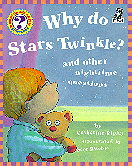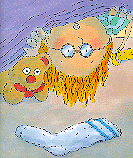


|
Why do Stars Twinkle? and other nighttime questions.
Catherine Ripley. Illustrated by Scot Ritchie. Subject Headings:
Kindergarten - grade 2 / Ages 5 - 7. ***/4
|

 Bedtime is much less scary for parent and child thanks to Catherine Ripley's Why do Stars Twinkle? and other nighttime questions. This book is the perfect nighttime companion for any parent who has struggled to find answers to such questions as "Why do I have to sleep?" and "Is there a man in the moon?" Like the previous volumes in the Question and Answer Story Book series, Why is Soap Slippery? and other bathtime questions, Do the Doors open by Magic? and other supermarket questions, and Why is the Sky Blue? and other outdoor questions, this latest volume responds to questions in a simplified, but factual manner. Catherine Ripley brings her experience as former editor of Chickadee Magazine to the project, as well as her talent for making complex explanations easier to understand.
Bedtime is much less scary for parent and child thanks to Catherine Ripley's Why do Stars Twinkle? and other nighttime questions. This book is the perfect nighttime companion for any parent who has struggled to find answers to such questions as "Why do I have to sleep?" and "Is there a man in the moon?" Like the previous volumes in the Question and Answer Story Book series, Why is Soap Slippery? and other bathtime questions, Do the Doors open by Magic? and other supermarket questions, and Why is the Sky Blue? and other outdoor questions, this latest volume responds to questions in a simplified, but factual manner. Catherine Ripley brings her experience as former editor of Chickadee Magazine to the project, as well as her talent for making complex explanations easier to understand.
The comic book style illustrations by Scot Ritchie will bring smiles of delight to children who are not quite sleepy enough to go to bed, and the bright splashes of colour are sure to soothe nighttime fears. Grandma, the narrator, is gloriously hip in a bright red suit and high heels and is always ready to respond to the jumble of questions from her knapsacked and bespeckled grandson. The nighttime theme is repeated througout the story; moons and stars twinkle across the night sky and are sprinkled across the grandson's blanket.
 The print is large and easy to read and the questions are bolded in black ink to make them stand out. Helpful diagrams are included to illustrate difficult words like "tendon" and "molecule". But make sure to keep a dictionary close at hand! Other difficult words like "cells" and "microscope" are not explained. For the most part, however, the information is conveyed in a simple, straightforward and entertaining manner that is sure to encourage an interest in science.
The print is large and easy to read and the questions are bolded in black ink to make them stand out. Helpful diagrams are included to illustrate difficult words like "tendon" and "molecule". But make sure to keep a dictionary close at hand! Other difficult words like "cells" and "microscope" are not explained. For the most part, however, the information is conveyed in a simple, straightforward and entertaining manner that is sure to encourage an interest in science.
One explanation that made me a little bit squeamish, but would no doubt appeal to kids, is the answer to the question:
What's under my bed?
"Some toys, a shoe, a book, a sock...and dust mites. Dust mites are tiny creatures so small you can't see them. But if you could shrink down thousands and thousands of times, you'd see dust mites under there, munching away. They chew on tiny falkes of dead skin and loose hair in the dust, and they sure do a good job of cleaning up!"
But Illustrator Scot Ritchie rises admirably to the task of making such creatures as dust mites and dancing molecules appear non-threatening, if not friendly.
The book is well-organized with a table of contents at the beginning, and additional nighttime bits of information at the end. It's a great size for little hands, and you can't beat the price!
Recommended
Jennifer Sullivan works with the Children's Literature Service of the National Library of Canada, and has a Master's degree in English Literature.

To comment on this title or this review, send mail to cm@umanitoba.ca.
Copyright © 1996 the Manitoba Library Association. Reproduction for personal use is permitted only if this copyright notice is maintained. Any other reproduction is prohibited without permission.
Published by
The Manitoba Library Association
ISSN 1201-9364
AUTHORS |
TITLES |
MEDIA REVIEWS |
BOOKSHELF
BACK ISSUES |
SEARCH |
HOME